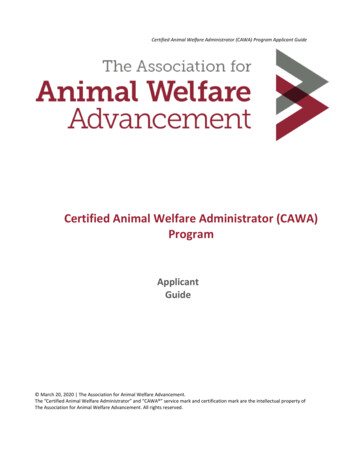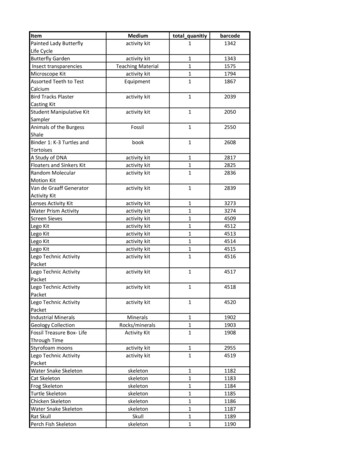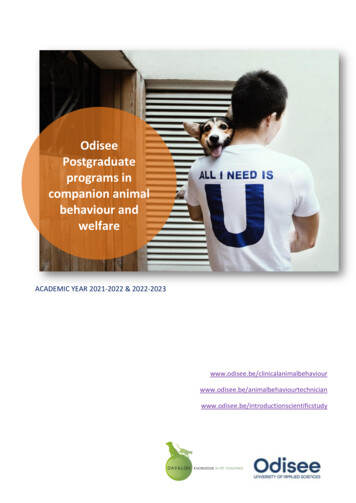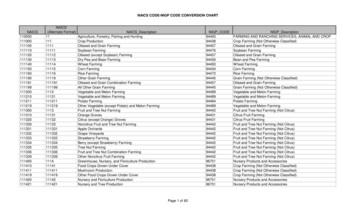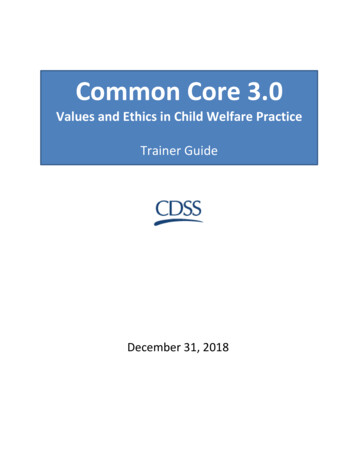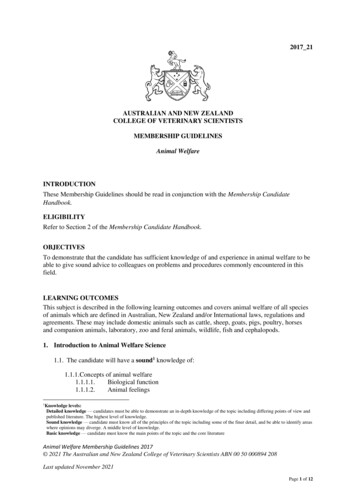
Transcription
2017 21AUSTRALIAN AND NEW ZEALANDCOLLEGE OF VETERINARY SCIENTISTSMEMBERSHIP GUIDELINESAnimal WelfareINTRODUCTIONThese Membership Guidelines should be read in conjunction with the Membership CandidateHandbook.ELIGIBILITYRefer to Section 2 of the Membership Candidate Handbook.OBJECTIVESTo demonstrate that the candidate has sufficient knowledge of and experience in animal welfare to beable to give sound advice to colleagues on problems and procedures commonly encountered in thisfield.LEARNING OUTCOMESThis subject is described in the following learning outcomes and covers animal welfare of all speciesof animals which are defined in Australian, New Zealand and/or International laws, regulations andagreements. These may include domestic animals such as cattle, sheep, goats, pigs, poultry, horsesand companion animals, laboratory, zoo and feral animals, wildlife, fish and cephalopods.1. Introduction to Animal Welfare Science1.1. The candidate will have a sound1 knowledge of:1.1.1. Concepts of animal welfare1.1.1.1.Biological function1.1.1.2.Animal feelings1Knowledge levels:Detailed knowledge — candidates must be able to demonstrate an in-depth knowledge of the topic including differing points of view andpublished literature. The highest level of knowledge.Sound knowledge — candidate must know all of the principles of the topic including some of the finer detail, and be able to identify areaswhere opinions may diverge. A middle level of knowledge.Basic knowledge — candidate must know the main points of the topic and the core literatureAnimal Welfare Membership Guidelines 2017 2021 The Australian and New Zealand College of Veterinary Scientists ABN 00 50 000894 208Last updated November 2021Page 1 of 12
1.1.1.3.1.1.1.4.1.1.1.5.1.1.1.6.Naturalness or telosThe constituents of animal wellbeing, animal suffering, and animal distressFrameworks to consider the needs of animals (e.g. Five Freedoms, FiveDomains)Scientific approaches to animal welfare, their use in assessment and theirlimitations1.2. The candidate will have a basic knowledge of:1.2.1. Domestication and use of animals1.2.2. Differences and similarities between animal rights and animal welfare concepts1.2.3. Factors influencing public perception of animal use and associated impact on animalwelfare2. The Ethics of Animal Use2.1. The candidate will have a basic knowledge of:2.1.1. Philosophical concepts for assessing human use of animals2.1.2. Practical ethical frameworks for harm/benefit analyses [consequentialist and nonconsequentialist approaches]2.1.3. The use of animals in research and teaching (The THREE Rs (refinement, reduction andreplacement)3. Psychological and Physiological Aspects of Adverse States3.1. The candidate will have a sound knowledge of:3.1.1. Behaviour3.1.1.1.Changes in behaviour reflecting welfare state3.1.1.2.Abnormal behaviour related to housing and husbandry3.1.1.3.Motivation, self-awareness, self-consciousness and cognition in animals3.1.2. Physiological3.1.2.1.Stress and its scientific evaluation3.1.3. Pain pathways, perception and response3.1.4. Relationships between disease and welfare e.g. lameness in cattle, leg weakness inbroilers, tail-biting in pigs4. Environment and Human Factors4.1. The candidate will have a sound knowledge of:4.1.1. Resource based factors4.1.1.1.The effects of environmental factors on welfare e.g. cage and pen design,stocking density, safety aspects, building design (humidity, noise etc), enrichment4.1.1.2.Welfare challenges of intensive and extensive farming systems4.1.1.3.Problems associated with social groupings or isolation4.1.2. Human animal relationship factorsAnimal Welfare Membership Guidelines 2017 2021 The Australian and New Zealand College of Veterinary Scientists ABN 00 50 000894 208Last updated November 2021Page 2 of 12
4.1.2.1.4.1.2.2.4.1.2.3.4.1.2.4.Human-animal bondSelection of animal attendants, animal technicians and stock personsStockmanship and productivityThe link between animal abuse and domestic violence5. The Veterinary Profession’s Role in Animal Welfare5.1. The candidate will have a basic knowledge of:5.1.1. Advocacy and advisory roles with stakeholders (including veterinarians, lawyers,government, industry, pet owners, animal welfare organisations and ethics committees)5.1.2. Leadership role in welfare for the profession and the community5.1.3. Advice on management of animal welfare during natural disasters and diseaseoutbreaks5.1.4. Veterinary professional ethics6. Veterinary Aspects of Animal Welfare6.1. The candidate will have a sound knowledge of:6.1.1. Pain recognition and assessment6.1.2. Methods of euthanasia and their assessment for humaneness6.2. The candidate will have a basic knowledge of:6.2.1. Pharmacokinetics of pain relief6.2.2. Welfare assessment of routine procedures such as spaying, castration, tail docking,mulesing, disbudding, branding6.2.3. Management of animals with hereditary problems including advice on breedingprogrammes7. Legislation and Animal Welfare7.1. The candidate will have a sound knowledge of:7.1.1. Animal welfare legislation (Acts and Regulations) in Australia and New Zealand and itsimplementation including enforcement7.1.2. Animal welfare codes of practice/standards and guidelines including regulation of theuse of animals for scientific purposes7.1.3. Animal welfare in quality assurance schemes7.2. The candidate will have a basic knowledge of:7.2.1. International, National and State Responsibilities7.2.2. Government committee structure7.2.3. Animal law – role and impact8. Contemporary Animal Welfare Issues8.1. The candidate will have a sound knowledge of:8.1.1. Production animals – live export, intensive production, dairyAnimal Welfare Membership Guidelines 2017 2021 The Australian and New Zealand College of Veterinary Scientists ABN 00 50 000894 208Last updated November 2021Page 3 of 12
8.1.2. Companion animals – overpopulation, brachycephalic breeds8.1.3. Wild animals (including captive, native and introduced)8.1.4. Sport and entertainment (racing, circuses and rodeos)Animal Welfare Membership Guidelines 2017 2021 The Australian and New Zealand College of Veterinary Scientists ABN 00 50 000894 208Last updated November 2021Page 4 of 12
EXAMINATIONSFor information on the required standard and format for both the Written and Oral examinations,candidates are referred to the Membership Candidate Handbook. The Membership examination hastwo separate, components:1.Written Examination (Component 1)Written Paper 1 (two hours): Principles of the SubjectWritten Paper 2 (two hours): Applied Aspects of the Subject2.Oral Examination (Component 2)Oral (one hour)The written examination will comprise of two separate two-hour written papers taken on the sameday. There will be an additional 15 minutes perusal time for each paper, during which no writing inan answer booklet is permitted. In each paper you are provided with six (6) questions to answer,worth 20 marks each, giving a total of 120 marks per paper. There is no choice of questions.Questions may be long essay type, a series of shorter answer sub-questions, or multiplechoice questions.Marks allocated to each question and to each subsection of questions will be clearlyindicated on the written paper.Written Paper 1:This paper is designed to test the candidate’s knowledge of the principles of animal welfare asdescribed in the Learning Outcomes. Where questions relate to general principles, answers may citespecific examples, but should primarily demonstrate an understanding of the underlying theoreticalbasis.Written Paper 2:This paper is designed to (a) test the candidate’s ability to apply the principles of animal welfare toparticular cases/problems or tasks and (b) test the candidate’s familiarity with the current practicesand issues that arise from activities within the discipline of animal welfare in Australia and NewZealand.Oral Examination:This examination requires the candidate to demonstrate achievement of the above mentioned LearningOutcomes. Discussion will be predominantly based on case material. The duration of thisexamination is approximately one (1) hour. A variety of multimedia is likely to be used during thisexamination. Five (5) cases are presented with supporting questions asked verbally in a face-to-facesetting. The oral examination has a total of 100 marks with each case allocated 20 marks.Animal Welfare Membership Guidelines 2017 2021 The Australian and New Zealand College of Veterinary Scientists ABN 00 50 000894 208Last updated November 2021Page 5 of 12
RECOMMENDED READING MATERIALThe candidate is expected to research the depth and breadth of the knowledge of the discipline. Thislist is intended to guide the candidate to some major references and source material. The list is notcomprehensive and is not intended as an indicator of the content of the examination.Recommended Texts and Resources2Appleby, M.C., Mench, J.A., Olsson, I.A.S. and Hughes, B.O., (Eds.). (2011). Animal Welfare. 2ndEdition Wallingford, UK, CAB International.Broom, D.M., and Fraser, A.F. (2015). Domestic animal behaviour and welfare. 5th Edition CABInternational, Wallingford, UK.Sandøe, P., and Christiansen, S.B. (2008). Ethics of animal use John Wiley and Son.Wathes, C.M., Corr, S.A., May McCulloch, S.P., and Whiting, M.C. (2011) Veterinary and AnimalEthics. Proceedings of the 1st International Conference on Veterinary and Animal Ethics. UFAW.Wiley-Blackwell.Yates, J. (2013). Animal Welfare in Veterinary Practice. UFAW Animal Welfare Series.Recommended Resources for LegislationAustralian State and Territory Animal Welfare Legislation and Codes of Practice.It is recommended that the candidate refer to the legislation and codes for their own particular state orterritory.The following article on the RSPCA Knowledgebase contains links to all Australian State/Territoryanimal welfare legislation (accessed February 17, 2017). What is the Australian legislation governinganimal welfare? islation-governing-animalwelfare 264.html)The Australian Animal Welfare Strategy (http://www.australiananimalwelfare.com.au/) [accessedMarch 7, 2017]New Zealand Animal Welfare LegislationMAF. Information on Animal Welfare Act 1999 and New Zealand Animal Welfare Strategy verviews/animal-welfare/) [accessed February 17,2017]MAF Animal Welfare Website imal-welfare/)[accessed February 17, 2017]2Definitions of TextbooksRecommended textbook – candidates should own or have ready access to a copy of the book and have a sound knowledge of the contents.Additional references – candidates should have access to the book and have a basic knowledge of the contents.Animal Welfare Membership Guidelines 2017 2021 The Australian and New Zealand College of Veterinary Scientists ABN 00 50 000894 208Last updated November 2021Page 6 of 12
Further readingAnimal Welfare ScienceFraser, D. (2008). Understanding animal welfare: The science in its cultural context. WileyBlackwell.Phillips, C.J.C. (2009). The Welfare of Animals: The Silent Majority. 220 pp. Springer, Dordrecht.OIE (2014) Animal Welfare: Focusing on the future. Vol 33 (1) Scientific and Technical Review.(http://boutique.oie.int/index.php?page ficprod&id produit 1307&fichrech 1)Sharp, T. & Saunders, G. (2011). A model for assessing the relative humaneness of pest animalcontrol methods. (Second Edition). Australian Government Department of Agriculture, Fisheries andForestry, Canberra ACT. Printed by: New Millennium Print.EthicsSinger, P. (2011). Practical Ethics. 3rd Edition. Cambridge University Press.Stephens, T. (2012). Chapter 19 ‘Veterinary Ethics’. In Applied Ethics: Strengthening EthicalPractices. Ed Bowden P. TIlde University Press.Sandøe, P., Corr, S., and Palmer, C. (2015). Companion Animal Ethics. UFAW Animal WelfareSeries.Verrinder, J.M., and Phillips, C.J.C. (2017). ‘Ethics and Animal Welfare’. In: Hodgson, J., and Pelzer,J. (Editors). Veterinary Medical Education: A Practical Guide. Wiley, Chichester, in press.Physiological and Psychological Aspects of WelfareGregory, N.G. (2004) Physiology and behaviour of animal suffering. Blackwell Publishing.Moberg, G.P., and Mench, J.A. (2000). The biology of animal stress: Basic Principles andImplications for Animal Welfare. CABI Publishing.Mellor, D.J., & Beausoleil, N.J. (2015). ‘Extending the “Five Domains” model for animal welfareassessment to incorporate positive welfare states’. Animal Welfare 24: 241-253.Mellor, D.J. (2017). Operational details of the Five Domains Model and its key applications to theassessment and management of animal welfare. Animals 7(8), 60;Environment and Human FactorsGregory, N., and Grandin, T. (2007). Animal Welfare and Meat Production. 2nd Edition CABIPublishing.Webster, J. (2011). Management and Welfare of Farm Animals: The UFAW Handbook. UFAWAnimal Welfare.Benson, G.H., and Rollin, B.E. (2004). The well-being of farm animals. Blackwell Publishing.Grandin, T. (2014). Livestock handling and transport. 4th Edition (T.Grandin, ed), CAB International,Wallingford, UK.Animal Welfare Membership Guidelines 2017 2021 The Australian and New Zealand College of Veterinary Scientists ABN 00 50 000894 208Last updated November 2021Page 7 of 12
Hemsworth, P.H., and Coleman, G.J. (1998). Human Livestock Interactions. The Stockperson and theProductivity and Welfare of Intensively Farmed Animals. New York, Oxford University Press.NZ MPI (2010). Good Practice Guide for the Use of Animals in Research, Teaching and Veterinary AspectsBorer-Weir, K. Chapter 5 ‘Analgesia’. In Clarke, K., Trim, C. (Eds.). (2013). Veterinary Anaesthesia.11th Edition. Elsevier.Flecknell, P. (2016). Laboratory animal anaesthesia. 4th Edition. London, Academic Press.Frank, D. ‘Recognising Behavioral Signs of Pain and Disease’ (2014). Vet Clin Small Anim. 44:507524.Overall, K.L. (2013). Manual of Clinical Behavioural Medicine for Dogs and Cats. Mosby.Other References in areas that might be of interestAbdul Rahman, S. (2017). ‘Religion and Animal Welfare - An Islamic Perspective’, Animals 7(2) 11,doi:10.3390/anni7020011Appleby, M.C., Mench, J.A., and Hughes, B.O. (2004). Poultry Behaviour and Welfare. CABIPublishing.Appleby MC, Cussen V, Gorces L, Lambert LA and Turner J (Eds) (2008) Long Distance Transportand Welfare of Farm Animals. CABI Publishing.Ascione FR (Ed) (2008) The International Handbook of Animal Abuse & Cruelty. Purdue UniversityPress.Blazina, C., Boyraz, G., and Shen-Miller, D. (Eds.). (2011). The Psychology of the Human-AnimalBond. Springer.Broom, D.M., and Johnson, K.G. (1993). Stress and Animal Welfare. London, Chapman and Hall(Kluwer Academic Publishers).Dawkins, M.S., and Bonney, R. (2008). The future of animal farming: Renewing the AncientContract. Wiley-Blackwell.Dolan, K. (1999). Ethics, animals and science. Blackwell Science.Grandin, T., and Deesing, M.J. (2014). Genetics and the Behaviour of Domestic Animals. AcademicPress.McGreevy, P. (2004). Equine Behaviour. Saunders.McMillan, F. (Ed.). (2005). Mental Health & Well-Being in Animals. Franklin BlackwellMellor, D.J. (2012). Animal emotions, behaviour and the promotion of positive welfare states. NewZealand Veterinary Journal 60, 1-8.Monamy, V. (1996). Animal Experimentation: A Student Guide to Balancing the Issues. Adelaide,ANZCCART. # )"Mullan, S., and Fawcett, A. (2017). Veterinary ethics: navigating tough cases. 5M.Panksepp, J. (1998). Affective neuroscience – The Foundation of Human and Animal Emotions.Oxford University Press.Phillips, C. (2002). Cattle Behaviour and Welfare. Blackwell Publishing.Rachels, J. (2014). The Elements of Moral Philosophy. McGraw-Hill.Animal Welfare Membership Guidelines 2017 2021 The Australian and New Zealand College of Veterinary Scientists ABN 00 50 000894 208Last updated November 2021Page 8 of 12
Regan, T. and Singer, P. (Eds.). (1989). Animal Rights and Human Obligations. 2nd Edition. NewJersey, Prentice-Hall.Rollin, B. (1998). The Unheeded Cry: Animal Consciousness, Animal Pain and Science. Iowa StateUniversity Press.Singer, P. (2001). Animal liberation. Ecco.Spedding, C.W.F. (2002). Animal Welfare. Earthscan.Theurer, M.E., et al (2013). ‘Remote noninvasive assessment of pain and health status in cattle’. VetClin Food Anim. 29:59-74Tiplady, C. (2013). Animal abuse: Helping Animals and People. CABI Publishing.Verrinder, J.M., McGrath, N., and Phillips, C.J.C. (2016). ‘Science, animal ethics and the law’. In: D.Cao and S. White (Eds), Animal Law and Welfare - International Perspectives. Springer, New York.p 63-85.Waran, N. (Ed.). (2002). The Welfare of Horses. Kluwer Academic Publishers.Webster, J. (2016). Animal welfare: Freedoms, dominions (sic) and ‘A Life Worth Living’. Animals6(5), 35.Webster, J. (2005). Limping towards Eden. Blackwell Science.Webster, J. (2013). Animal Husbandry regained: The place of farm animals in sustainableagriculture. Earthscan.Young, R.J. (2003). Environmental Enrichment for Captive Animals. UFAW.Springer Animal Welfare Series: The Welfare of Cats (Ed. I. Rochlitz, 2005) The Welfare of Laboratory Animals (Ed. E. Kaliste, 2004) The Welfare of Dogs (Author K. Stafford, 2005) The Welfare of Cattle (Authors J. Rushen, A.M. de Passillé, M.A.G. von Keyserlingk andD.M. Weary, 2008) The Welfare of Pigs (Ed. J.M. Marchant, 2009) The Welfare of Sheep (Ed. C.M. Dwyer, 2009) The Welfare of Animals: the Silent Majority (Author C.J.C. Phillips, 2009) The Welfare of Poultry and other Captive Birds (Eds. I.J. Duncan and P. Hawkins, 2010) Education in Animal Welfare (Author, T. Eadie, 2011) The Welfare of Farmed Flightless Birds (Eds. P. Glatz, C. Lunam and I. Malecki, 2011).Springer Animal Behaviour Series: Stress and Animal Welfare (Authors D. Broom and K. Johnson)Animal Welfare Membership Guidelines 2017 2021 The Australian and New Zealand College of Veterinary Scientists ABN 00 50 000894 208Last updated November 2021Page 9 of 12
Journals3Recommended JournalsAnimal WelfareAnimalsAnthrozoosApplied Animal Behaviour ScienceAustralian Veterinary JournalJournal of Applied Animal Welfare ScienceJournal of the American Veterinary Medical AssociationNew Zealand Veterinary JournalThe Veterinary JournalAdditional JournalsAustralian Veterinary PractitionerCanadian Veterinary JournalJournal of Veterinary: Clinical Applications and ResearchJournal of Veterinary Medical EducationLaboratory AnimalsVeterinary Clinics of North AmericaInformation Resource CentresAnimal Behaviour (resources for applied ethology) www.animalbehaviour.net [Accessed March 7,2017]Animal Welfare Science and Bioethics Centre, Massey University New oethics-centre home.cfm) [Accessed March 7,2017]Animal Welfare Science Centre, Melbourne Australia (http://www.animalwelfare.net.au) [AccessedMarch 7, 2017]ANZCCART (http://www.adelaide.edu.au/ANZCCART/) [Accessed March 7, 2017]Centre for Animal Welfare and Ethics l-welfareand-ethics) [Accessed March 7, 2017]International Fund for Animal Welfare (IFAW) Resource re) [Accessed March 7, 2017]RSPCA Australia (http://kb.rspca.org.au/) [Accessed February 17, 2017]Universities Federation for Animal Welfare (UFAW) (http://www.ufaw.org.uk/) [Accessed March 7,2017]World Animal Protection Resources for Veterinary reprofessionals [Accessed March 7, 2017].3Definitions for journals:Recommended Journal – candidates should have ready access to either print or electronic versions of the journal and have a soundknowledge of the published articles in the subject area.Additional Journal – candidates should be able to access either printed or electronic versions of the journal and have a basic knowledge ofthe published articles in the subject area.Animal Welfare Membership Guidelines 2017 2021 The Australian and New Zealand College of Veterinary Scientists ABN 00 50 000894 208Last updated November 2021Page 10 of 12
Animal Welfare Membership Guidelines 2017 2021 The Australian and New Zealand College of Veterinary Scientists ABN 00 50 000894 208Last updated November 2021Page 11 of 12
World Organisation for Animal Health (OIE) Animal l-welfare-at-a-glance/) [Accessed March 7, 2017]American Veterinary Medical Association Animal Welfare(https://www.avma.org/Pages/home.aspx) [Accessed March 7, 2017]Anthrozoology Research Group (ARG) (http://www.anthrozoologyresearchgroup.com/) [AccessedMarch 7, 2017]Australian Veterinary Association (http://ava.com.au) [Accessed March 7, 2017]BVA Animal Welfare Foundation (https://www.bva-awf.org.uk/advice-vets) [Accessed March 7,2017]Canadian Council on Animal Care (http://www.ccac.ca/en /) [Accessed March 7, 2017]New Zealand Veterinary Association(http://www.nzva.org.nz) [Accessed March 7, 2017]One Welfare http://onewelfare.cve.edu.au/ [Accessed March 7, 2017]FURTHER INFORMATIONFor further information contact the College OfficeTelephone:International 61 (07) 3423 .org.auPostal Address:Building 3, Garden City Office Park, 2404 Logan RoadEIGHT MILE PLAINS QLD 4113 Australia 2021 The Australian and New Zealand College of Veterinary Scientists ABN 00 50 000894 208This publication is copyright. Other than for the purposes of and subject to the conditions prescribed under theCopyright Act, no part of it may in any form or by any means (electronic, mechanical, microcopying,photocopying, recording or otherwise) be reproduced, stored in a retrieval system or transmitted without priorwritten permission. Enquiries should be addressed to the Australian and New Zealand College of VeterinaryScientists.Animal Welfare Membership Guidelines 2017 2021 The Australian and New Zealand College of Veterinary Scientists ABN 00 50 000894 208Last updated November 2021Page 12 of 12
choice questions.Marks allocated to each question and to each subsection of questions will be clearly indicated on the written paper. Written Paper 1: This paper is designed to test the candidate's knowledge of the principles of animal welfare as described in the Learning Outcomes. Where questions relate to general principles, answers may cite


